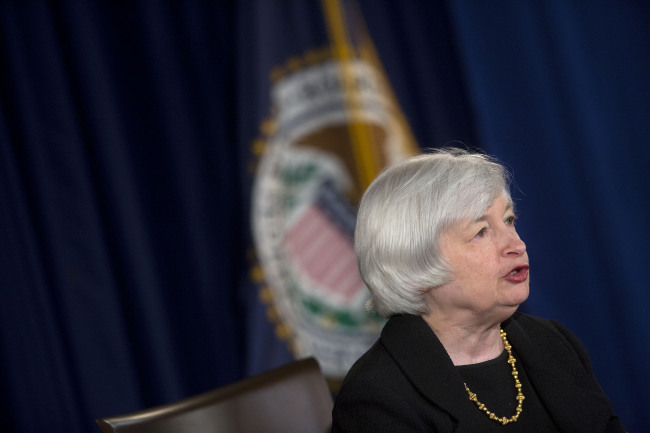WASHINGTON ― When the Federal Reserve announced the end of its landmark bond buying program Wednesday, it also signaled the start of something else: The Janet Yellen era.
Officially, Yellen has been Fed chair since February. But the phase-out of the bond-buying stimulus program Yellen inherited from her predecessor, Ben Bernanke, truly marks her inauguration. She can now begin to fully stamp her influence on the central bank.
With the job market showing steady gains, Yellen must now grapple with the fateful decision of when to raise short-term interest rates, which the Fed has kept at record lows since 2008 to help the economy.
“Janet Yellen’s ability to place her mark on the nation’s monetary policy is only now opening up,” said Scott Anderson, chief economist at Bank of the West. “It will largely be Yellen” who guides rates back to their historic averages from near-zero levels.
 |
Janet Yellen, chair of the U.S. Federal Reserve. (Bloomberg) |
Yellen will also preside over the unwinding of the Fed’s vast portfolio of bonds, which its purchases have magnified to more than $4 trillion, a record high. The bond buying had been designed to keep long-term loan rates low.
Bernanke’s tenure at the Fed was focused on bolstering the financial system and rescuing the economy. Yellen’s will require a delicate balancing act to bring the Fed back to normal: She must withdraw the Fed’s stimulus without destabilizing the economy.
“If we’re moving to an era where things will become less accommodative, then we’re in the Yellen era,” said Jay Bryson, a global economist at Wells Fargo.
For Yellen and other Fed officials, the decision of when to begin raising rates toward their historic averages hinges on two major economic forces: Jobs and inflation.
A recent hot streak in job growth has shrunk the unemployment rate to 5.9 percent from 7.2 percent a year ago. Those gains suggest that the Fed may begin to lift rates earlier than expected.
In a statement it issued after ending a policy meeting Wednesday, the Fed noted that hiring is strengthening and that the excess of would-be job holders is “gradually diminishing.” Accordingly, it must eventually withdraw its stimulus.
The statement’s mention of “solid’’ job gains doesn’t mean the economy has regained full strength in Yellen’s eyes ― particularly because pay growth has been all but flat and housing has lagged behind the rest of the recovery.
“There is a long way between saying that and the labor market is healthy,’’ said Richard Moody, chief economist at Regions Financial.
Surges in hiring usually cause prices to rise, yet inflation has remained persistently below the Fed’s 2 percent target. Muted inflation suggests a weaker economy than indicated by the falling unemployment rate.
The Fed did reiterate its plan to maintain its benchmark short-term rate near zero “for a considerable time.” Most economists predict the Fed won’t raise that rate, which affects many consumer and business loans, before June.
But its confirmation that it would end its bond buying program and perhaps move closer to a rate increase suggested the start of a new period for the Fed.
On balance, economists saw the Fed’s statement as showing less concern about unusually low inflation, which has helped delay a rate increase. Some analysts said the market reaction Wednesday indicated that investors saw the Fed statement as at least setting the stage for rate hikes starting sometime next year.
“The trick will be normalizing interest rates without creating another recession or unleashing higher inflation or adding to global financial instability and financial bubbles,” Anderson said.
Michael Hanson, senior economist at Bank of America Merrill Lynch, said the Fed still appears likely to put off any rate increase until at least mid-2015.
“This isn’t the Fed rushing to the exits,’’ he said.
Hanson noted that while the Fed kept its “considerable time’’ phrasing, it added language stressing that any rate increase would hinge on the economy’s health. Previously, many analysts had interpreted the “considerable time” phrase to mean the Fed wouldn’t raise rates for a specific period after it ended its bond purchases.
The Fed’s statement was approved 9-1. The one dissent came from Narayana Kocherlakota, president of the Fed’s regional bank in Minneapolis. He contended that the Fed should have signaled its intention to maintain a record-low benchmark rate until the inflation outlook has reached the central bank’s 2 percent target. And he argued that the Fed should have continued its bond purchases at the current pace.
Yellen has stressed that while the unemployment rate is close to a historically normal level, other gauges of the job market remain a concern. These include stagnant pay; many part-time workers who cannot find full-time jobs; and a historically high number of people who have given up looking for a job and are no longer counted as unemployed. (AP)








